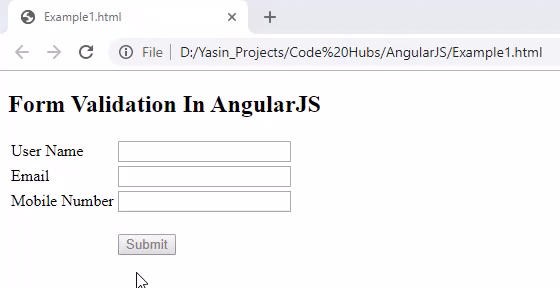In this article, we will learn about how we can validate a form in AngularJS.
AngularJS offers client-side form validation.
Example
Open the Example1.html file and add the code in it.
<!DOCTYPE html>
<html>
<head>
<script src="https://ajax.googleapis.com/ajax/libs/angularjs/1.7.8/angular.min.js"></script>
<title></title>
<style>
.labelWarning {
color: #FF0000;
}
</style>
</head>
<body ng-app="">
<h2>Form Validation In AngularJS</h2>
<form name="myForm">
<table>
<tr>
<td>User Name</td>
<td>
<input name="txtName" ng-model="txtName" required>
<span class="labelWarning" ng-show="myForm.txtName.$touched && myForm.txtName.$invalid">User Name is required.</span>
</td>
</tr>
<tr>
<td>Email</td>
<td>
<input type="email" name="txtEmail" ng-model="txtEmail" required>
<span class="labelWarning" ng-show="myForm.txtEmail.$touched && myForm.txtEmail.$invalid">
<span ng-show="myForm.txtEmail.$error.required">Email is required.</span>
<span ng-show="myForm.txtEmail.$error.email">Invalid Email address.</span>
</span>
</td>
</tr>
<tr>
<td>Mobile Number</td>
<td>
<input type="text" name="txtMobile" ng-model="txtMobile" ng-pattern="/^[0-9]{10,10}$/" maxlength="10" required>
<span class="labelWarning" ng-show="myForm.txtMobile.$touched && myForm.txtMobile.$invalid">
<span ng-show="myForm.txtMobile.$error.required">Mobile Number is required.</span>
<span ng-show="myForm.txtMobile.$error.pattern">Mobile Number should be 10 digits.</span>
</span>
</td>
</tr>
<tr>
<td></td>
<td><br /><input type="submit" ng-disabled="myForm.$invalid"></td>
</tr>
</table>
</form>
</body>
</html>
- The HTML5 required attribute, to specify that the input field must be filled out.
- The AngularJS $touched state returns true if a control has lost focus.
- The AngularJS $invalid state returns true if the model is invalid.
- The AngularJS $error object contains all the validation attributes applied to the specified control.
- The AngularJS ng-pattern directive is used to add up a regex pattern validator to ngModel on <input> element.
- The HTML5 maxlength attribute, to specifies the maximum number of characters allowed in the <input> element.
- The AngularJS $invalid state returns true if the form content is not valid.
Output:

Also, check How To Call API In AngularJS


